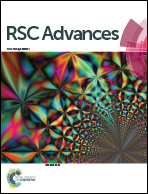Nanoscale characteristics of antibacterial cationic polymeric brushes and single bacterium interactions probed by force microscopy
Abstract
Cationic brushes are powerful molecules for antibacterial purposes with permanent activity and mobility. Therefore, clarifying the characteristics of the brush structure and related interactions with microbial cells becomes important. In this study, two different molecular weight (Mn: 1800 and 60 000) polyethyleneimine (PEI) molecules were grafted on a polyurethane (PU) surface. Moreover, an alkylation step was performed to enhance the antibacterial efficiency by increasing the polycationic character of the PEI brushes. The surface potential of the PEI brushes was raised with an additional alkylation step. Nanoscale characterization of the PEI brushes on PU surfaces was examined in terms of topography, roughness, and surface potentials by Kelvin Probe Force Microscopy (KPFM). The nanomechanical behaviour of the PEI brushes was investigated in Milli-Q water and phosphate buffer saline by Atomic Force Microscopy (AFM). The nanomechanical properties were directly affected by the incubation medium and surface properties. Additionally, polymeric brush–single bacterium interactions were probed by Single Cell Force Spectroscopy (SCFS). The antibacterial activity of the PEI brushes was probed at a single bacterium level with the Escherichia coli K-12 bacteria species. As a result, rupture forces between E. coli K-12 and the alkylated PEI grafted surface were calculated to identify the bacterial adhesion process at piconewton force sensitivity. It was found that, alkylated high molecular weight PEI brushes show the lowest rupture force (56.1 pN) with the lowest binding percentage (%5) against single bacterial cells. This study indicated that, increasing the chain length, charge (alkyl groups) and mobility of PEI brushes decreases the binding percentage and force at a single bacterium level, synergistically.


 Please wait while we load your content...
Please wait while we load your content...